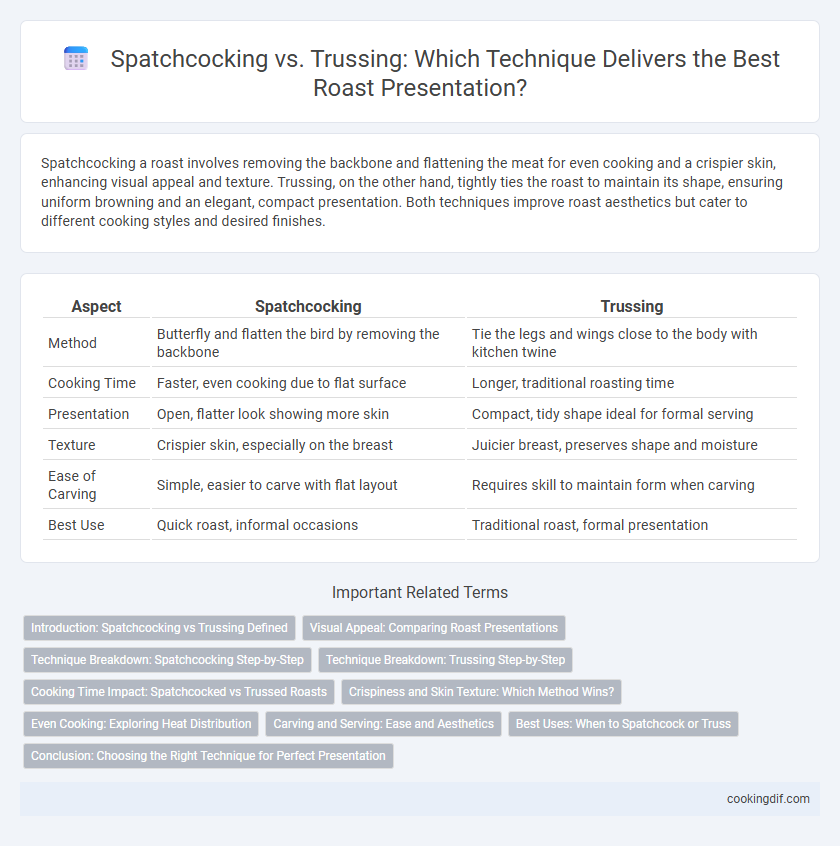Spatchcocking a roast involves removing the backbone and flattening the meat for even cooking and a crispier skin, enhancing visual appeal and texture. Trussing, on the other hand, tightly ties the roast to maintain its shape, ensuring uniform browning and an elegant, compact presentation. Both techniques improve roast aesthetics but cater to different cooking styles and desired finishes.
Table of Comparison
| Aspect | Spatchcocking | Trussing |
|---|---|---|
| Method | Butterfly and flatten the bird by removing the backbone | Tie the legs and wings close to the body with kitchen twine |
| Cooking Time | Faster, even cooking due to flat surface | Longer, traditional roasting time |
| Presentation | Open, flatter look showing more skin | Compact, tidy shape ideal for formal serving |
| Texture | Crispier skin, especially on the breast | Juicier breast, preserves shape and moisture |
| Ease of Carving | Simple, easier to carve with flat layout | Requires skill to maintain form when carving |
| Best Use | Quick roast, informal occasions | Traditional roast, formal presentation |
Introduction: Spatchcocking vs Trussing Defined
Spatchcocking involves removing the backbone and flattening the bird, allowing for even roasting and crispier skin, while trussing ties the bird to maintain its shape and ensure uniform cooking. Each method enhances roast presentation by influencing the bird's appearance and texture, with spatchcocking providing a visually impressive, flat roast and trussing yielding a compact, traditional form. Understanding these techniques helps optimize cooking outcomes and elevates the aesthetic appeal of roasted poultry.
Visual Appeal: Comparing Roast Presentations
Spatchcocking a roast results in a flatter, more even presentation that enhances the crispiness of the skin and exposes more surface area for uniform browning, creating a visually striking dish. Trussing maintains the traditional rounded shape, giving the roast a compact, elegant appearance ideal for formal settings where a classic presentation is preferred. Both techniques influence the roast's appeal, with spatchcocking emphasizing rustic, crispy visuals while trussing highlights symmetrical, tidy presentation.
Technique Breakdown: Spatchcocking Step-by-Step
Spatchcocking a roast involves removing the backbone to flatten the meat, promoting even cooking and crispier skin. Begin by placing the roast breast-side down, then use poultry shears or a sharp knife to cut along both sides of the backbone, removing it entirely. Press down firmly to flatten the roast before seasoning and roasting, enhancing presentation with a uniform, golden crust.
Technique Breakdown: Trussing Step-by-Step
Trussing a roast involves tying the meat with kitchen twine to ensure even cooking and an attractive presentation. Begin by positioning the roast with the seam side up, then create a series of loops around the meat, securing each with a tight knot every inch or so. Finish by tying the ends firmly to maintain shape and prevent the roast from spreading during cooking, resulting in a uniform, professional-looking roast.
Cooking Time Impact: Spatchcocked vs Trussed Roasts
Spatchcocking a roast significantly reduces cooking time by flattening the meat, allowing for more even heat distribution and faster, consistent roasting. Trussed roasts maintain their traditional shape but often require longer, slower cooking to ensure the center reaches the desired doneness without drying out the exterior. Choosing between spatchcocking and trussing directly affects roasting efficiency and texture, with spatchcocking favored for quicker meals and trussing preferred for classic presentation and even cooking in larger cuts.
Crispiness and Skin Texture: Which Method Wins?
Spatchcocking a roast exposes more surface area to direct heat, promoting superior crispiness and evenly browned, crackling skin texture. Trussing, while maintaining a compact shape, can result in uneven crisping due to restricted air flow and limited skin exposure. For optimal roast presentation with a perfectly crispy, golden exterior, spatchcocking emerges as the preferred technique.
Even Cooking: Exploring Heat Distribution
Spatchcocking enhances even cooking by flattening the roast, allowing heat to circulate uniformly across the meat, reducing cooking time and preventing overcooked edges. Trussing, on the other hand, maintains the roast's shape, promoting consistent thickness that supports more controlled heat distribution but may result in longer, less uniform cooking. Optimizing heat exposure through spatchcocking ensures balanced doneness, while trussing preserves presentation with moderate heat regulation.
Carving and Serving: Ease and Aesthetics
Spatchcocking a roast allows it to cook evenly and lie flat, making carving simpler and providing a visually appealing presentation with uniform slices. Trussing maintains the roast's traditional shape, enhancing juiciness and a compact form, but can make carving more challenging due to its rounder profile. The choice affects serving ease and aesthetics, with spatchcocking favoring accessibility and trussing emphasizing a classic, formal look.
Best Uses: When to Spatchcock or Truss
Spatchcocking is ideal for roasting whole poultry when even cooking and crispy skin are desired, especially for smaller birds like chickens or Cornish hens. Trussing best suits larger roasts or whole birds that benefit from compact shape retention, ensuring uniform cooking and an elegant presentation, such as turkeys or prime rib. Choose spatchcocking to reduce cooking time and achieve maximum skin crispiness, while trussing maintains moisture and structural integrity for traditional roast shapes.
Conclusion: Choosing the Right Technique for Perfect Presentation
Spatchcocking creates an even, flat surface that enhances Maillard reaction and ensures uniform browning for a visually appealing roast. Trussing maintains the roast's traditional shape, promoting an elegant, compact presentation with defined contours. Selecting either technique depends on the desired aesthetic and cooking style, with spatchcocking favoring crispness and trussing favoring classic form.
Spatchcocking vs Trussing for Roast Presentation Infographic

 cookingdif.com
cookingdif.com